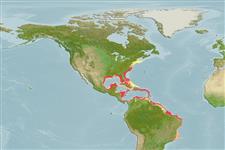>
Scombriformes (Mackerels) >
Scombridae (Mackerels, tunas, bonitos) > Scombrinae
Etymology: Scomberomorus: Latin, scomber = mackerel + Greek, moros = silly, stupid (Ref. 45335).
More on author: Cuvier.
Environment: milieu / climate zone / depth range / distribution range
بوم شناسي
دريايي; اقیانوس رو (Ref. 51243); تغييرات عمق 5 - 140 m (Ref. 36484), usually 5 - 15 m (Ref. 40849). Tropical; 44°N - 22°S, 98°W - 34°W (Ref. 54879)
Western Atlantic: Canada (Ref. 5951) to Massachusetts, USA to São Paulo, Brazil. Eastern Central Atlantic: St. Paul's Rocks (Ref. 13121).
Length at first maturity / Size / Weight / سن
Maturity: Lm 64.8, range 45 - 114 cm
Max length : 184 cm TL جنس نر / بدون خواص جنسي; (Ref. 9710); common length : 70.0 cm FL جنس نر / بدون خواص جنسي; (Ref. 168); بيشينه وزن گزارش شده: 45.0 kg (Ref. 168); بيشينه سن گزارش شده: 26 سال ها (Ref. 128047)
خارهاي باله پشتي (کل) : 12 - 18; شعاع نرم باله پشتي (کل) : 15 - 18; خارهاي باله مخرجي: 0; شعاع نرم باله مخرجي: 16 - 20; مهره ها: 41 - 43. Interpelvic process small and bifid. Swim bladder absent. Lateral line abruptly curving downward below second dorsal fin. Intestine with 2 folds and 3 limbs. Adults have no black area on the anterior part of the first dorsal fin. Juveniles with bronze spots in 5 or 6 irregular rows. Body entirely covered with scales.
Often found in outer reef areas. Larvae are encountered in surface waters of 26.3° to 31°C and 26.9 to 35 ppt. Feeds primarily on fishes with smaller quantities of penaeid shrimps and squids. Large schools have been found to migrate over considerable distances along the Atlantic US coast, water temperature permitting. It is an important species for recreational, commercial, and artisanal fisheries throughout its range. Most of the catch is processed into steaks or sold fresh, or sometimes canned and salted. Also prepared smoked and frozen (Ref. 9987). Potentially ciguatoxic in certain areas (Ref. 9710). Sometimes called "Kingfish" (Ref. 13442).
Life cycle and mating behavior
بلوغ | تولید مثل | تخم ریزی | تخم ها | Fecundity | توزاد ( لارو)
Collette, B.B. and C.E. Nauen, 1983. FAO Species Catalogue. Vol. 2. Scombrids of the world. An annotated and illustrated catalogue of tunas, mackerels, bonitos and related species known to date. Rome: FAO. FAO Fish. Synop. 125(2):137 p. (Ref. 168)
وضعيت در فهرست قرمز IUCN (Ref. 130435: Version 2024-2)
خطر برای انسان ها
Reports of ciguatera poisoning (Ref. 9710)
استفاده انسانی
ماهي گيري – شيلات: تجاري; ماهي ها ي سرگرم كننده: بله
ابزارها
گزارش های ويژه
بارگيری XML
منابع اينترنتي
Estimates based on models
Preferred temperature (Ref.
123201): 23.5 - 28.1, mean 27.2 °C (based on 1034 cells).
Phylogenetic diversity index (Ref.
82804): PD
50 = 0.5000 [Uniqueness, from 0.5 = low to 2.0 = high].
Bayesian length-weight: a=0.00912 (0.00713 - 0.01166), b=3.02 (2.98 - 3.06), in cm total length, based on LWR estimates for this species (Ref.
93245).
Trophic level (Ref.
69278): 4.4 ±0.3 se; based on diet studies.
Generation time: 6.1 (4.5 - 7.3) years. Estimated as median ln(3)/K based on 31
growth studies.
جهندگی (Ref.
120179): متوسط, كمينه زمان لازم براي دو برابر شدن جمعيت 4/1 – 4/4 سال (K=0.07-0.15; tm=2; tmax=14; Fec=70,000).
Prior r = 0.47, 95% CL = 0.31 - 0.71, Based on 3 full stock assessments.
Fishing Vulnerability (Ref.
59153): Moderate to high vulnerability (48 of 100).
Climate Vulnerability (Ref.
125649): Moderate to high vulnerability (55 of 100).
Nutrients (Ref.
124155): Calcium = 20.3 [9.2, 71.9] mg/100g; Iron = 0.707 [0.314, 1.640] mg/100g; Protein = 20.6 [19.4, 21.9] %; Omega3 = 0.238 [0.149, 0.393] g/100g; Selenium = 74.7 [27.2, 232.8] μg/100g; VitaminA = 17.7 [4.4, 77.8] μg/100g; Zinc = 0.568 [0.380, 0.903] mg/100g (wet weight); based on
nutrient studies.
